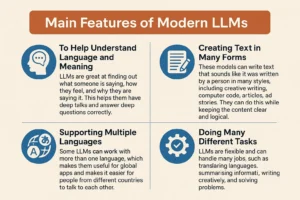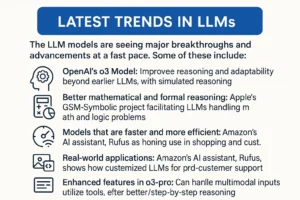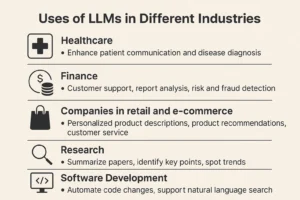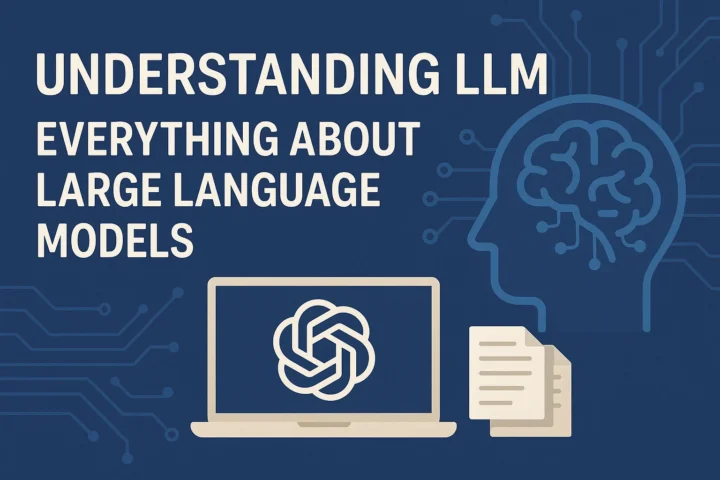Breaking Down Large Language Models
To better understand the Large Language Model (LLM) meaning, it is a type of advanced artificial intelligence (AI) that learns from huge amounts of text to understand, summarise, create, and predict new text. It is built using a deep learning method called the transformer. An LLM powers many popular AI tools like chatbots, content creators, and translation apps by using self-learning techniques to process human language. LLMs have become well-known because they helped make generative AI popular and are now a key focus for many organisations looking to use AI in different business areas and tasks.
The Working Mechanism Behind Large Language Models (LLMs)
Now that we have seen what is LLM, are you curious to learn how exactly they work? LLMs are trained on huge amounts of text, mostly from the internet, and by doing this, they learn how language works, including patterns, subtle details, and sentence structure. This helps LLMs write text that sounds like it was written by a person to answer questions, write articles, poems, and even write computer code. One important skill these models have is being able to solve problems and give replies that make sense.
It has many layers that focus on different parts of the text using a technique called self-attention and feed-forward neural networks. This is called transformer architecture or a big language model transformer. This helps the model understand the text and remember important parts as it works through it.
Main Features of Modern Large Language Models (LLMs)

Check out the main features of LLMs today, which prove to be beneficial to users:
- To Help Understand Language and Meaning: LLMs are great at finding out what someone is saying, how they feel, and why they are saying it. This helps them have deep talks and answer deep questions correctly.
- Creating Text in Many Forms: These models can write text that sounds like it was written by a person in many styles, including creative writing, computer code, articles, and stories. They can do this while keeping the content clear and logical.
- Supporting Multiple Languages: Some LLMs can work with more than one language, which makes them useful for global apps and makes it easier for people from different countries to talk to each other.
- Doing Many Different Tasks: LLMs are flexible and can handle many jobs, such as translating languages, summarising information, writing creatively, and solving problems.
Latest Trends in Large Language Models (LLMs)

The LLM models are seeing major breakthroughs and advancements at a fast pace. Some of these include:
- OpenAI’s o3 Model: This model is meant to improve reasoning and adaptability beyond earlier LLMs. It does great at complicated thinking, problem-solving, and multi-step logic. It also adds simulated reasoning, which lets the model pause, review, and improve answers for greater accuracy.
- Better Mathematical and Formal Reasoning: Apple’s GSM-Symbolic project is all about making it easier for LLMs to deal with math and logic problems. This is part of ongoing work to make AI better at complex thinking.
- Models that are faster and more efficient: The goal of the new models is to make LLMs work faster and use less memory, especially when they have to deal with long inputs. For instance, GemFilter is a new method that makes inference more efficient and uses less memory.
- Real-World Applications: Amazon’s AI assistant, Rufus, shows how customised LLMs are being used in practical tools for shopping and customer support.
- Enhanced Features in o3-pro: It can handle multimodal inputs like text and images; it can use tools like web browsing and coding helpers, and it has better step-by-step reasoning for more complex professional jobs.
Uses of Large Language Model (LLMs) in Different Industries
 In today’s day and age, LLMs prove to be of great use not just in one or two but a variety of industries. Here’s how they help make a difference:
In today’s day and age, LLMs prove to be of great use not just in one or two but a variety of industries. Here’s how they help make a difference:
- Healthcare: Large Language Models (LLMs) are helping healthcare by improving how patients communicate and by assisting in diagnosing diseases. They power smart virtual health assistants that can understand tricky patient questions and give accurate answers.
- Finance: LLMs make it easier to help customers in banks and other financial institutions, while also helping them read through complicated reports, spot trends, and learn more about how to make better investment choices. They also help find risks and fraud.
- Companies in retail and e-commerce: They use LLMs to make personalised product descriptions, suggest products, and improve customer service. This helps customers get answers fast, find products they like, and make better decisions about what to buy.
- Research: LLMs are helpful for research because they can quickly process a lot of data. This means they can help scientists summarise long research papers, find key points, and spot trends.
- Software Development: In software development, LLMs make coding faster by writing and changing code automatically. They also make apps easier to use by supporting voice commands and better language search features.
Challenges and Things to Keep in Mind
While there are many benefits of these LLM models, there are certain challenges that are also posed by these models:
- Bias and Fairness: LLMs can copy unfair biases from the data they learn from, which leads to biased or unfair answers. Careful data selection and regular checks are needed to reduce bias.
- Accuracy and Hallucination: Sometimes LLMs give answers that sound correct but are actually wrong, also called “hallucination”. Important data should always be checked twice by users.
- Privacy and Security: To learn, LLMs need a lot of data, some of which may be private or secret. There is a risk that models may unintentionally leak or copy private data.
- Effects on the Environment: Training big LLMs takes a lot of computer power and energy, which can be bad for the environment.
The Future of Large Language Model (LLMs)
What’s in store for the future? To understand this, let’s have a look at some of the trends of LLMs for the future:
- Independent Task Performers: LLMs that can work on complex jobs by themselves, often working with other tools to reach a goal.
- Understanding Individual Users: Models that learn about personal preferences, ways of talking, and the unique needs of each user.
- Working with Robots: Using language skills together with physical actions to build smarter robots.
- Improved Thinking Skills: Creating models that can reason better and solve problems more effectively.
Getting Started with Large Language Model (LLMs)
Want to incorporate the benefits of LLM models in your daily routine? Then here are the ways you can, whether you are a business or an individual:
- APIs: A lot of businesses give LLM services through APIs. This means that app makers don’t have to build the models themselves in order to add language features.
- Ready-Made Models: You can get or buy LLMs that have already been trained. You can use these models right away to do everyday things.
- Making Your Own Models: Companies with specific needs and enough money can make their own LLMs that are perfect for their needs.
Conclusion
Large Language Models (LLMs) are a big step forward in artificial intelligence because they let computers understand and create language that sounds like it was spoken by humans with a level of accuracy and flexibility that has never been seen before. LLM can do a huge variety of language-related jobs that are necessary in many fields, ranging from healthcare to the software industry.
In this AI-driven world, it’s important to know what is LLM used for and how they work, whether you are a student, a developer, or a business owner. But as technology keeps getting better, it’s important to find a balance between new ideas and moral concerns and make sure they are used responsibly.

